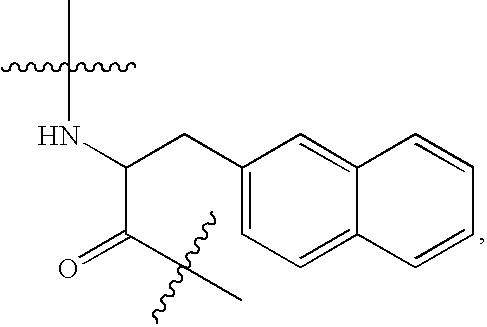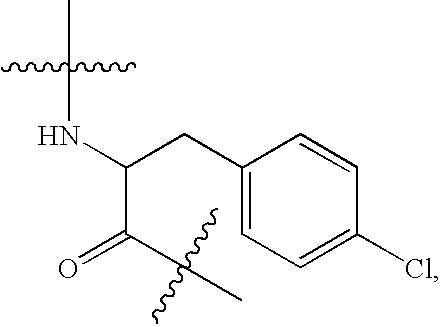Method of preparing peptide
a peptide and peptide technology, applied in the field of peptide preparation, can solve the problems of increased number of steps, unavoidably involved a highly hygroscopic n-unprotected peptide, and other problems, and achieve the effects of fewer steps, high purity, and high yield
- Summary
- Abstract
- Description
- Claims
- Application Information
AI Technical Summary
Benefits of technology
Problems solved by technology
Method used
Image
Examples
example 1
N-acetyl-D-2-naphthylalanyl-D-4-chlorophenylalanine methyl ester (Ac-D-2Nal-D-4ClPhe-OMe)
[0184]N-acetyl-D-2-naphthylalanine (25.7 g, 0.1 mol) and D-4-chlorophenylalanine methyl ester hydrochloride (25.0 g, 0.1 mol) were suspended in acetonitrile (600 ml), subsequently 1-hydroxybenzotriazole monohydrate (15.3 g, 0.1 mol) was added and the suspension was cooled to 5° C. N-methylmorpholine (11.0 ml, 0.1 mol) and 1-(3-dimethylaminopropyl)-3-ethylcarbodiimide hydrochloride (19.17 g, 0.1 mol) were then added and the suspension was stirred at 5° C. for 1 hour followed by stirring at room temperature overnight. The precipitated crystals were separated and washed with acetonitrile (100 ml). The crystals were dried under reduced pressure at 40° C. to yield 42.0 g of the desired compound. The yield was 92.3%, the purity was 99.53 area %, and the diastereomer was not detected (undetectable).
[0185]1H-NMR(DMSO-d6) δ(ppm): 1.71(s, 3H), 2.82-2.96(m, 2H), 3.02-3.13(m, 2H),3.54(s, 3H), 4.49(m, 1H), 4...
example 2
N-acetyl-D-2-naphthylalanyl-D-4-chlorophenylalanine (Ac-D-2Nal-D-4ClPhe-OH)
[0187]N-acetyl-D-2-naphthylalanyl-D-4-chlorophenylalanine methyl ester (42.0 g, 92.7 mmol) was suspended in THF (460 ml) and the suspension was cooled to 0 to 5° C. A 1M aqueous solution of sodium hydroxide (97.4 mL, 97.4 mmol) was added drop-wise at a temperature of 0 to 5° C. over 30 minutes. The suspension was then stirred at the same temperature for 6 hours until completion of hydrolysis. The temperature was then increased to 15 to 20° C. followed by removal of insoluble materials by filtration. After water (690 ml) was added, the filtrate was adjusted to pH 2 by the addition of 6M hydrochloric acid (19 ml) to facilitate crystallization. The precipitated crystals were subsequently separated and washed with a mixture of THF and water (2:3) (40 ml). The crystals were dried under reduced pressure at 40° C. to yield 40.1 g of the desired compound. The yield was 97.6%, the purity was 99.0 area %, and the diast...
example 3
N-acetyl-D-2-naphthylalanyl-D-4-chlorophenylalanyl-D-3-pyridylalanine methyl ester (Ac-D-2Nal-D-4ClPhe-D-3Pal-OMe)
[0190]N-acetyl-D-2-naphthylalanyl-D-4-chlorophenylalanine (4.39 g, 10 mmol) was suspended in acetonitrile (120 ml), 1-hydroxybenzotriazole monohydrate (1.68 g, 11 mmol) was added, and the suspension was cooled to 5° C. Subsequently, 1-(3-dimethylaminopropyl)-3-ethylcarbodiimide hydrochloride (2.0 g, 10.5 mmol) was added and the suspension was stirred at 5° C. for 1 hour, followed by stirring at room temperature overnight. The suspension was again cooled to 5° C., D-3-pyridylalanine methyl ester dihydrochloride (2.66 g, 10.5 mmol) and triethylamine (2.92 ml, 21 mmol) were added, and the suspension was stirred at room temperature for 4 hours. The precipitated crystals were separated and washed with acetonitrile (20 ml). The diastereomer ratio of the crude crystal (DDD:DLD) was 99.6:0.4. These crude crystals were suspended in water (60 ml) and THF (45 ml), and the pH was ad...
PUM
| Property | Measurement | Unit |
|---|---|---|
| reaction time | aaaaa | aaaaa |
| reaction time | aaaaa | aaaaa |
| reaction time | aaaaa | aaaaa |
Abstract
Description
Claims
Application Information
 Login to View More
Login to View More - R&D
- Intellectual Property
- Life Sciences
- Materials
- Tech Scout
- Unparalleled Data Quality
- Higher Quality Content
- 60% Fewer Hallucinations
Browse by: Latest US Patents, China's latest patents, Technical Efficacy Thesaurus, Application Domain, Technology Topic, Popular Technical Reports.
© 2025 PatSnap. All rights reserved.Legal|Privacy policy|Modern Slavery Act Transparency Statement|Sitemap|About US| Contact US: help@patsnap.com



